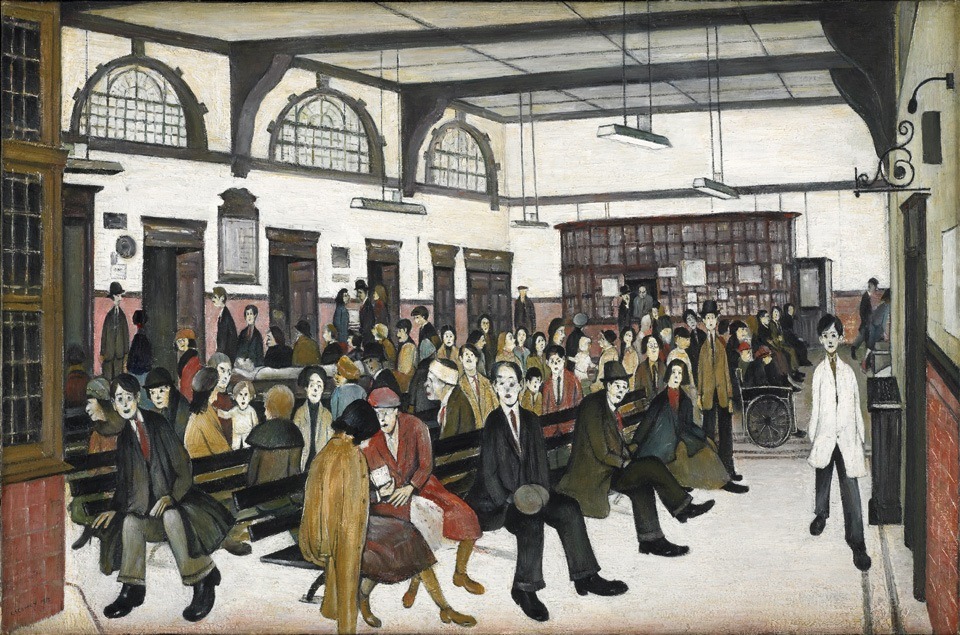(Source: Tate)
On the BBC a couple for weekends ago, I heard an expert on the Middle East describing how the civil war in Syria was worsening by the day. He said something like, “Some of the opposition are not nice middle class liberals, you know.” The clear implication was that working-class rebels were the really bad ones, the “other” that “we” had to fear.
|
Working class people are often portrayed as the “other” that “we” have to fear. Yet there was a time, as the work of English painter L.S. Lowry suggests, when this gap wasn’t so wide.
|
I thought about that vision of the working class the when I visited a fantastic and soon-to-close exhibition at London’s Tate Britain art gallery of the work of 20th-century artist L.S. Lowry (1887-1976). Lowry and the Painting of Modern Life has been an unexpected blockbuster. Importantly, most reviews have made specific reference to the working-class focus of both this curation and Lowry’s work. Walking through the six large rooms of this powerful retrospective, an observer can’t ignore class, nor the places where the English working class lived and toiled. Lowry was a painter of industry and labor, and the notes to the exhibition quote his explanation of his work: “I saw the industrial scene and I was affected by it. I wanted to get a certain effect on the canvas. I couldn’t describe it, but I knew it when I got it.”
Lowry painted ordinary life on the streets of his native Lancashire, including Salford in the North West of England where a fantastic gallery bears his name and highlights his work. Ordinary life for Lowry had industry as its backdrop—factories and mills that his trademark matchstick men and women tumble into or out of as their shifts changed. Even his paintings of working-class leisure, depicting football matches and street entertainment, are dominated by the prospect of work and the smoke-belching chimneys that defined northern England at that time. Lowry does not shy away from the grimness of working-class life. His painting reflects street brawls, house repossessions and those crippled by industrial accident and disease.
Where the exhibition is especially powerful in its juxtaposition of Lowry’s art with a series of quotes from commentators, some directly addressing the artist’s craft and others offering more general insights into the working-class world he painted. These included poignant extracts from books like Robert Roberts’ The Classic Slum, George Orwell’s The Road to Wigan Pier, and Richard Hoggart’s The Uses of Literacy as well as quotes from a John Berger essay.
I was reminded just how good the prose in many books about working-class life in the middle years of the twentieth century was. The writing was thoughtful and reflective but pointed. Above all, it was attentive to the working-class experience, a lived experience rooted often in poverty or the fear of it. Consider, for example, this quote from Hoggart’s book, embossed on the wall of the gallery, reflecting simple points about the use of working-class language: “Today if I hear someone using words like ‘sorrow’ and ‘misery’ freely, they usually sound slightly archaic. To my grandmother they were regular words, together with ‘care’ and ‘hardship.’ When she spoke of someone ‘taking the bread from her mouth’ she was not being dramatic or merely figurative.”
These excerpts give the viewer pause, as they were designed to do. Lowry’s art and the contemporary writing from and about the working class contextualize each other. Each art form mirrors the other’s subject matter, the one leveraging understanding of the other. As a working sociologist, I was brought up short by both the paintings and the writing. In just these four writers—and there were others—we see a focus on working-class subjects from Orwell in the 1930s, Hoggart in the 1950s, Berger in the 1960s, and finally Robert’s writing from the 1970s.
A four decades span in which working-class life improved immeasurably even as more popular attention was paid to the lived experience of class and the vision of further improvement. These were writers whose books sold widely in paperback or whose essays were read and helped to form a shared understanding of class matters and a common sense of citizenship. It was perhaps no accident that British sociology and cultural studies expanded in these decades following the Second World War and, early on at least, class was central to its calling.
The exhibition begged many questions about our own age. Lowry’s canvasses recorded a bleak world that few if any would long to return to. If Lowry represented the poverty of working-class life and the heavy price industry demanded of the people and places where it was based in its heyday, then these same paintings in turn raise questions about these inner cities in Northern England now. But above all the exhibition for me prompted consideration of the presence of the working class in popular art and writing now. Lowry’s art has always been popular. What must have been a cheap reproduction hung in a corridor of my primary school, for instance. But his art also often graced the covers of books about the working class in the decades after the Second World War when serious attention was being paid to them by the likes of Berger and Hoggart. For sure, the working class was often presented as an object of fascination; as “different” from the middle class who researched or wrote about them. There was, though, a care in that attention and an expression of humanity and recognition in the encounter between classes.
So while there has always been a distance between classes, at times in our history this gap has been narrowed. The geographic distance between Syria and Salford is a long one, but perhaps the void in class understanding may be greater still.
Tim Strangleman is a Sociologist at the University of Kent and co-author of Work and Society: Sociological Approaches, Themes and Methods.



0 Comments